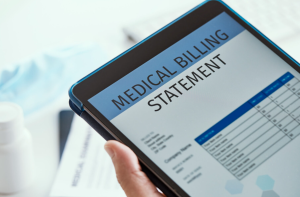Level 3 Medical Billing is an essential component of the healthcare industry, dedicated to efficiently and accurately processing medical claims. With a focus on complex healthcare services, Level 3 Medical Billing ensures proper documentation, coding, and reimbursement for procedures such as surgical operations and specialized treatments. This critical phase of the billing process requires expertise and in-depth knowledge of medical terminology, insurance regulations, and billing guidelines. By proficiently handling Level 3 Medical Billing, healthcare providers can ensure streamlined operations, timely reimbursements, and ultimately, superior patient care.

Introduction
Level 3 Medical Billing is a critical component of the healthcare industry, playing a vital role in ensuring the financial health of medical practices and healthcare facilities. This comprehensive article will delve into the definition, requirements, responsibilities, systems, benefits, challenges, and training involved in Level 3 Medical Billing. By providing a comprehensive understanding of Level 3 Medical Billing, this article aims to equip healthcare professionals with the necessary knowledge and insights to excel in this field.
Definition of Level 3 Medical Billing
Level 3 Medical Billing refers to the process of submitting and following up on medical claims from healthcare providers to insurance companies. It involves intricate tasks such as coding diagnoses and procedures, completing claim forms, verifying insurance coverage, and reconciling payments and denials. Level 3 Medical Billing focuses on more complex medical cases and requires a deep understanding of medical coding, insurance policies, and reimbursement procedures.
Requirements for Level 3 Medical Billing
To excel in Level 3 Medical Billing, certain requirements must be met. Firstly, a strong knowledge of medical terminology, anatomy, and physiology is essential to accurately code diagnoses and procedures. Proficiency in medical coding systems such as ICD-10 and CPT is also necessary. Additionally, excellent analytical and problem-solving skills are crucial for resolving billing discrepancies, negotiating with insurance companies, and handling complex medical cases. Strong communication and interpersonal skills are also vital for efficiently interacting with healthcare professionals, insurance representatives, and patients.
Responsibilities of a Level 3 Medical Biller
A Level 3 Medical Biller has a wide array of responsibilities. One of their primary duties is to accurately code diagnoses and procedures according to established coding guidelines. This ensures that medical claims are correctly submitted to insurance companies, preventing potential claim denials or underpayments. Additionally, Level 3 Medical Billers verify insurance coverage for patients, ensuring that services rendered are eligible for reimbursement. They also handle claim submissions, follow up on unpaid or rejected claims, and manage any appeals or disputes with insurance companies to secure maximum reimbursement for healthcare providers. Moreover, Level 3 Medical Billers often play a critical role in educating healthcare providers about proper documentation and coding practices to enhance the accuracy and completeness of medical claims.
Understanding Level 3 Medical Billing Systems
Level 3 Medical Billing utilizes specialized software systems to facilitate the billing process. These systems, such as electronic health record (EHR) systems or practice management software, enable Level 3 Medical Billers to efficiently code and submit claims, track claim status, and manage patient accounts. These systems often have built-in coding tools, insurance databases, and reporting functionalities, streamlining the billing workflow. Additionally, Level 3 Medical Billing systems often integrate with other healthcare IT systems, such as medical coding software and billing clearinghouses, to ensure seamless data exchange and reduce errors.
Benefits of Level 3 Medical Billing
Level 3 Medical Billing offers several benefits to healthcare providers and medical practices. Firstly, it ensures the timely and accurate submission of claims, leading to faster reimbursement and improved cash flow. By effectively communicating with insurance companies and resolving claim denials or underpayments, Level 3 Medical Billers maximize revenue for healthcare providers. Accuracy in coding diagnoses and procedures also reduces the risk of audits and penalties, safeguarding the financial stability of medical practices. Moreover, Level 3 Medical Billing allows healthcare providers to focus on patient care instead of administrative tasks, enhancing overall efficiency.
Challenges in Level 3 Medical Billing
While Level 3 Medical Billing offers numerous benefits, it also comes with its fair share of challenges. The constantly evolving landscape of medical coding guidelines and insurance policies requires Level 3 Medical Billers to stay updated with the latest changes. This necessitates continuous education and retraining to ensure accurate coding and claim submission. Moreover, the complex nature of Level 3 Medical Billing often involves dealing with denied or underpaid claims, requiring strong negotiation and problem-solving skills. The increasing prevalence of audits also adds to the challenges, as healthcare providers must ensure compliance with regulatory requirements and documentation standards to avoid penalties.
Comparison of Level 3 Medical Billing with Other Levels
When comparing Level 3 Medical Billing with other levels, such as Level 1 or Level 2, several distinctions can be observed. Level 1 Medical Billing mainly involves basic administrative tasks, such as patient registration and data entry, with limited involvement in coding or claim submission. Level 2 Medical Billing expands on Level 1 by incorporating more comprehensive coding and claim submission responsibilities. However, it still focuses on relatively simpler medical cases. In contrast, Level 3 Medical Billing handles more complex medical cases, requiring advanced coding knowledge, insurance coverage verification, and expertise in resolving billing discrepancies. As the level increases, the involvement in coding and the complexity of responsibilities also increase.
Training and Certification for Level 3 Medical Billing
To excel in Level 3 Medical Billing, comprehensive training and certification are crucial. Many educational institutions and professional organizations offer specialized courses and programs in medical billing and coding. These programs cover topics such as medical terminology, anatomy and physiology, coding systems (ICD-10, CPT), reimbursement methodologies, insurance policies, and billing regulations. Obtaining a certification, such as the Certified Professional Biller (CPB) certification offered by the AAPC (American Academy of Professional Coders), further validates the competence and expertise of Level 3 Medical Billers.
Conclusion
Level 3 Medical Billing involves intricate tasks that play a vital role in the financial stability of healthcare providers. This comprehensive article aimed to provide a thorough understanding of Level 3 Medical Billing, covering its definition, requirements, responsibilities, systems, benefits, challenges, and training. By mastering Level 3 Medical Billing, healthcare professionals can ensure accurate claim submission, maximize reimbursement, and contribute to the overall effectiveness and success of medical practices.
